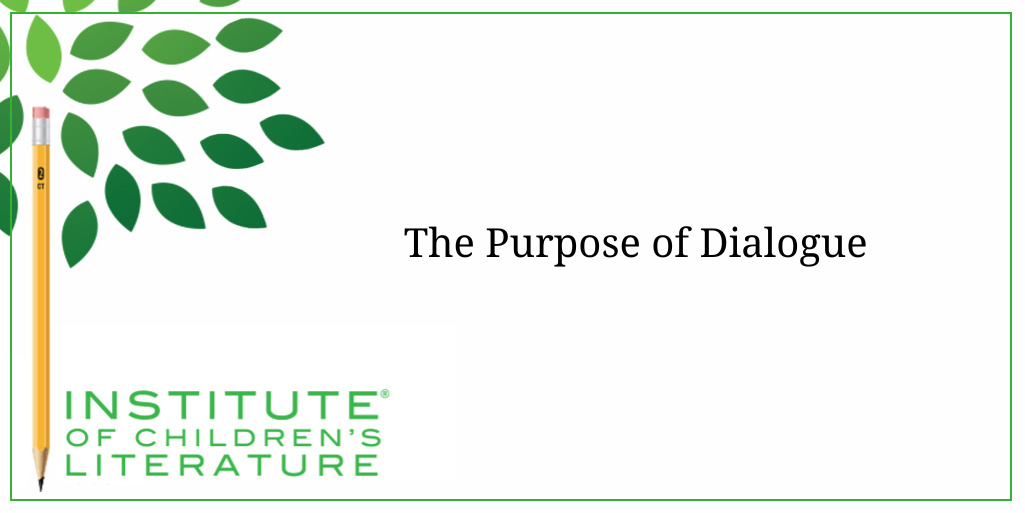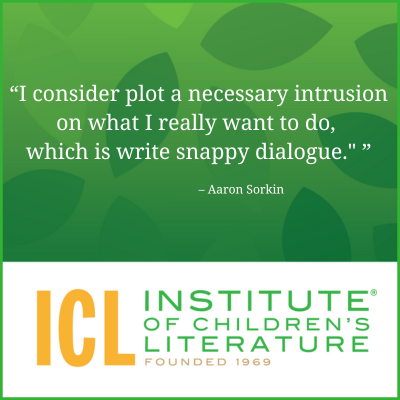
5 Ways Writers Can Prep for 2025 Goal Setting
Before we roll on to the new writing year, let’s harness our optimism for the blank slate before us and prepare for our 2025 Goal Setting just for writers.

In Alice in Wonderland, Alice opines “What is the use of a book without pictures or conversations?” I tend to agree with Alice, at least where novels are concerned. I like the conversations.
Dialogue brings so much to any story. It allows us to hear the voice of each character. It allows us to hear the thoughts of our non-viewpoint characters, or at least those thoughts they’re willing to share.
Dialogue gives us a sense of immediacy because dialogue always puts us directly into a specific moment of the story. In fact, dialogue is as close to essential for fiction as any element can be. So, this month we’re going to look at dialogue closely.
If you’ve read any writing advice, ever, you’ve surely been told to show and not tell. Showing and telling relate to immediacy in your story. When you show, you bring the reader into specific moments of the story. When showing, we hear the characters speak in their own voices. We see the characters’ actions and reactions. We experience the sensory detail of that moment in the story.

Telling, on the other hand, allows us to take a step back. We see the story from more of a distance, and we speed up time. Hours, days, weeks, and even years can be skimmed over through telling. Both showing and telling are important because we simply cannot show every moment of a story. We can’t listen to everything your main character says in a given day. We can’t listen to every voice your main character hears. No one has that much time. And it would slow the story to the point of exhaustion. So we make decisions about when to speed along through telling and when to pause and dig in through showing. Dialogue is part of that decision.
Dialogue takes place at a specific moment in time. If I tell you that Jack said, “Never speak to me again,” you assume he said it at a specific moment in time. When we hear Jill’s reply to that demand, the moment in time expands and we slip into dialogue. We hear each character’s voice. For instance, in the words, “Never speak to me again,” we can hear Jack’s forcefulness.
In an expanded scene, we may hear him say other things that underscore his emotions as well as other elements of his personality. We’ll also learn things about Jill through the way she responds. For instance, imagine the conclusions you might make if Jill says, “I will speak to you when I want, and you’ll listen, too!” We certainly wouldn’t say Jill is wishy-washy with a response like that. But if her response is a single word, a sniffly “please,” then we get a totally different impression of Jill.
It is the immediacy of dialogue that makes it such an amazing vehicle to reveal things about characters.
The closeness of dialogue demands skill from the writer. Dialogue must reveal character. But it doesn’t do it by having the characters tell one another about themselves. This especially fails if you have two characters who know one another well. Consider the following exchange between siblings:
“We went to the park this morning,” Pepper said. “And I brought my doll.”
“You brought your doll,” said Bo, “because you always bring that thing wherever you go.”
“I bring her because I love her,” Pepper said. “But now I can’t find her.”
“You aren’t holding her. You must have dropped her.”
“I dropped her,” Pepper wailed.
This kind of dialogue appears in stories by new writers often. Pepper is telling Bo things he already knows. He knows they went to the park. He knows she brought her doll. She knows she takes the doll everywhere. She knows she isn’t holding it. In real-life conversations, we generally refrain from telling one another things we already know. If your sibling suddenly started unloading stuff you already know on you, you’d probably be fairly snarky in reply.
“We went to the park this morning,” Pepper said. “And I brought my doll.”
“Yeah, I know,” said Bo. “I was there.”
“I bring her because I love her,” Pepper said. “But now I can’t find her.”
“You aren’t holding her.”
“I know I’m not holding her,” Pepper said. “Can’t you say something helpful?”
Dialogue isn’t real-life conversation. Dialogue is, however, a stylized version of real-life conversation. Real-life conversation rambles and trails off for no particular reason. Real-life conversation uses lots of extra words and aimless small talk and partial sentences.
Dialogue, on the other hand, is purposeful, direct, and clear. When it rambles, it is because the writer is showing you something about the character. When it trails off, the writer is showing you something about the character. Less time is spent on things like greetings and transitions. Have you ever noticed in movies, for instance, how often characters end calls without saying “goodbye?” This is because written dialogue omits pointless verbalizations, even though they are part of real-life conversations. In books, this is less obvious than in movies and television shows. We have come to accept the compressed conversations that make up written fictional dialogue as real enough.

photo credit: football wife via pexels
Dialogue is set in scenes. and thus in specific story moments. So, dialogue is a tool of showing. But dialogue can also be used to tell. For instance, dialogue can let us recap something we don’t want to expand into an actual scene or give us details of an event our main character didn’t attend. Consider the following:
“How mad is coach?” Joel asked.
“Mad,” Peter said. “He asked me why you weren’t at practice. I didn’t tell him anything.”
“I appreciate that,” Joel said. “Do you think I’m off the team?”
Peter didn’t answer right away, and Joel felt his stomach sink as he waited.
“Yeah,” Peter said finally. “He said you don’t need to come back.”
In this short exchange, we get all we need to know about an event (sports practice) that the viewpoint character didn’t attend. We could have chosen to write a scene where Joel peered at practice from behind the bleachers and heard the coach directly, but here we get the important parts without as many words.
There is nothing wrong with using dialogue to tell as long as you can make it sound real. The truth is that we tell one another things all the time. We recap events. We tell stories from our past. We explain ourselves. It’s part of real conversation. The key is to make sure the dialogue you create is one that could happen in real life. For instance, this isn’t real-life telling:
“Oh, Mabel, I haven’t seen you since last month when you learned your cousin was going to quit school.”
“Right. And you were telling me your brother did the same thing. And he turned to a life of crime right after.”
“I’m sure that won’t happen to your cousin. How is he?”
“He robbed a liquor store.”
“Oh, bummer.”
This is more information dumping that most readers want to see, and it doesn’t ring very true. The only time you’d ever want to do it is if you’re writing some kind of soap opera parody. Dialogue can give us useful information, but only if it does it in a way that tricks the reader’s ear into hearing it as normal conversation.
To do that, you have to be careful to keep the information as short as possible. Notice in the section where Peter was telling Joel about a missed sports practice that the exchange is short and the information minimal. As much as possible, we want the reader to fill in the blanks.
In this short exchange, the reader gets information beyond what is being said through Peter’s choices. Peter chooses to assure Joel that he didn’t tell the coach anything. That shows us something about Peter and Joel’s relationship, something not said directly. And later Peter’s pause gives us space to imagine. What dialogue often serves to do is prompt the reader’s imagination so the reader will fill in those things that are implied but unsaid.
Dialogue can be used to direct a reader’s attention this way as well. For example, in the mystery stories I write, I often sneak important clues into the text just before a burst of attention-getting dialogue. In that way, I’m giving the reader the tools to solve the mystery (the clue) but then immediately directing the reader’s attention in another direction through the dialogue.
Another thing dialogue can do is lie. Characters don’t have to tell one another the truth. This is something readers can forget so if you need the reader led astray for a time, you can simply have a character lie in front of the reader. Just as in real life, readers will have to choose what to believe and what to doubt.
Pages full of print can be intimidating. When I read academic papers as part of research, I am often met with pages full of nothing but text. It’s intimidating and it demands a lot of the reader to focus and make it through. And if that is true of me, an adult reader with strong reading skills, imagine what a wall of text does to younger readers.
This is why early reader stories have short sentences and short paragraphs. That adds white space to the page and makes the reading less intimidating. Dialogue serves this purpose too. It’s one reason why books with lots of action will often have a main character and a “buddy” for him to go through the adventure with. This buddy allows for dialogue, and the dialogue offers a break from the extreme focus needed to process paragraphs of informational text. This is probably one reason why Alice liked stories with pictures and conversations.
It’s important not to become so enamored with dialogue that we forget the value of everything else. I’ve seen writers try to use dialogue to do the work of narrative by having characters tell one another their every action.
Dialogue cannot do it all. But used well, dialogue is one of a writer’s most valuable tools.
Let’s get together next week for more conversation.
With over 100 books in publication, Jan Fields writes both chapter books for children and mystery novels for adults. She’s also known for a variety of experiences teaching writing, from one session SCBWI events to lengthier Highlights Foundation workshops to these blog posts for the Institute of Children’s Literature. As a former ICL instructor, Jan enjoys equipping writers for success in whatever way she can.

Before we roll on to the new writing year, let’s harness our optimism for the blank slate before us and prepare for our 2025 Goal Setting just for writers.

Writers can be thin-skinned when it comes to getting feedback on their work. Let’s look at 4 ways to positively deal with constructive criticism!

Rejection is part of the territory when it comes to being a writer. Today we offer reflection for writers to help redirect your efforts after a rejection.
1000 N. West Street #1200, Wilmington, DE 19801
© 2024 Direct Learning Systems, Inc. All rights reserved.
1000 N. West Street #1200, Wilmington, DE 19801
© 2024 Direct Learning Systems, Inc. All rights reserved.
1000 N. West Street #1200, Wilmington, DE 19801
© 2024 Direct Learning Systems, Inc. All rights reserved.
1000 N. West Street #1200, Wilmington, DE 19801
© 2024 Direct Learning Systems, Inc. All rights reserved.

1000 N. West Street #1200, Wilmington, DE 19801
© 2025 Direct Learning Systems, Inc. All rights reserved.

1000 N. West Street #1200, Wilmington, DE 19801
©2025 Direct Learning Systems, Inc. All rights reserved. Privacy Policy.
1 Comment